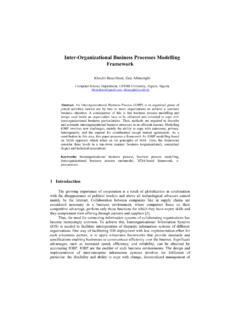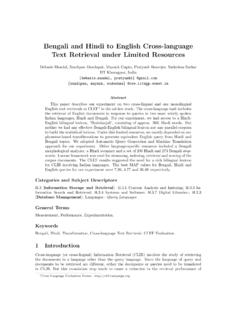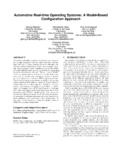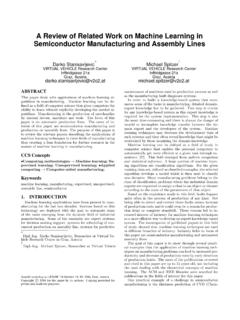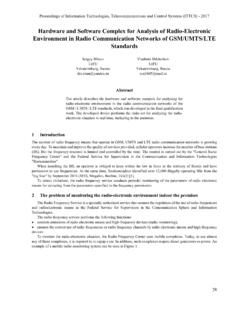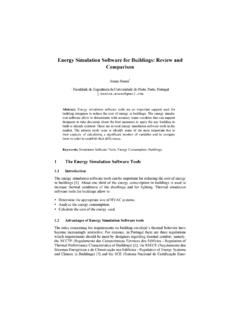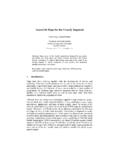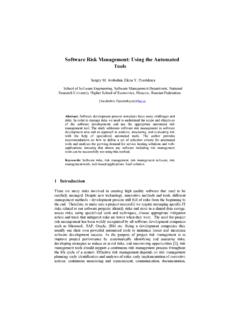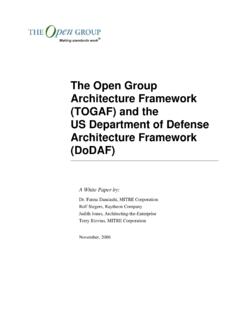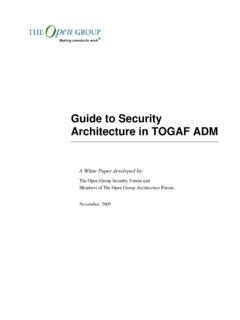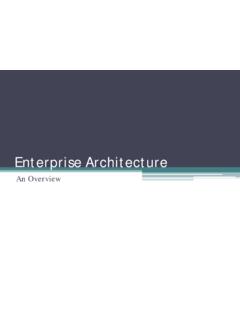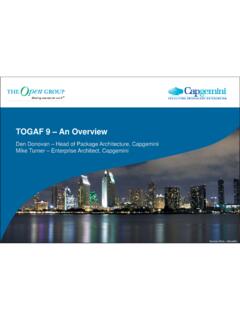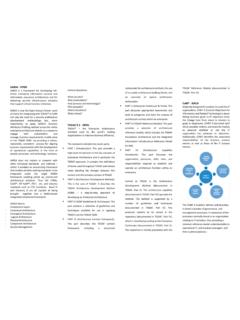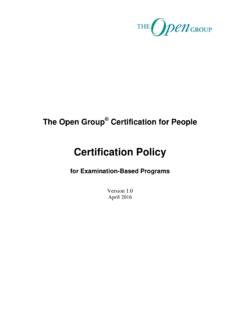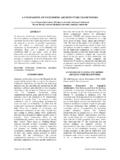Transcription of A case of integration between ITIL and TOGAF vFinal
1 A case of integration between itil and TOGAF Nelson Gama1,2,3, Pedro Sousa2,4, Miguel Mira da Silva2,3 1 CINAV-PT Navy Research Center, Escola Naval, Portugal 2 Instituto Superior Tecnico, Lisboa, Portugal 3 INOV, Lisboa, Portugal 4 Link Consulting, Lisboa, Portugal Abstract. Different efforts have been developed focusing on the alignment between organizations concepts. From these initiatives, two have had outstanding relevance: The Open Group Architecture Framework ( TOGAF ) and IT Infrastructure Library ( itil ). However, these two approaches are often used complementarily and simultaneously. Beyond the difficulties associated with governance, parallel projects with similar initiatives imply the duplication of resources and thus costs.
2 The integration of both approaches in a same referential avoids the need to adopt different frameworks covering overlapping topics. This paper presents a case of integration between two of the most known and used frameworks, respectively TOGAF and itil . We demonstrated and evaluated our case applied in a field study inside a public organization. Keywords: itil , TOGAF , ArchiMate, integration . 1 Introduction The growing dependence on IT leads to the improvement of initiatives focusing the business/IT alignment and cost reduction [1, 2]. The alignment between business and IT requires an integrated approach to all concepts and artifacts of the organization [3, 4]. With this aim, a disparate myriad of frameworks and different approaches that have been developed [5].
3 From these initiatives, two have had outstanding relevance: Enterprise Architecture (EA) and IT Service Management (ITSM). However, they are increasingly overlapping and even though ITSM and EA are both managerial approaches and business oriented, they have different focus: ITSM primarily focus is on IT service management [6] while EA is related to alignment, organization representation, and IT Governance as the basis for enterprise representation [7]. Once ITSM and EA are not connected their respective teams work separately with little opportunity to share expertise. On the other hand, these two approaches developed in parallel imply a duplication of efforts and resources, loosing synergies and increasing costs.
4 The efforts spent in managing organizational data and resources from these two different initiatives might become unmanageable, which will influence the effectiveness and benefits of both implementations. 2 Although some have tried to integrate these two approaches by identifying several benefits from the relationship and integration of ITSM and EA, the results are far from satisfactory [8-11]. In this paper, we1 present a case of integration between EA and ITSM through the integration of their two best known and used frameworks, respectively The Open Group Architecture Framework - TOGAF [12] and IT Infrastructure Library - itil [13]. 2 Background EA is recognized as the core element for the representation, in layers, concepts and artifacts, of an organization s systems and properties and how they are related.
5 EA allow us to observe the organization from different views and perspectives in a coherent whole of principles, methods and models, used as an integrated approach in the design of the whole enterprise s organizational structure [7, 14-18]. Different needs, scopes and authors have proposed different EA frameworks with common principles. From these frameworks, TOGAF [12] has major relevance and widespread acceptance [19, 20] motivating our focus in TOGAF framework. itil is a the de facto standard to IT Service Management in a collection of process oriented best practices, documented over the years, related to the effective and efficient management of IT. One of itil main concepts is the service orientation, involving layers and components common to the TOGAF framework.
6 Moreover, itil encapsulates a composition of architectures, namely business, processes, information, application, and infrastructure. However, itil neither provides a complete coverage for all phases within TOGAF nor does itil specifies implementation details [21]. The modeling of itil is made from a concept description in natural language, while itil processes are usually depicted as well defined sequences of activities by flow charts [22]. The representations to describe itil domains seem to lack a common, clear and formal notation and semantic. The definition of service management in itil , as a set of specialized organizational capabilities for providing value to customers in the form of services [23], establishes a clear link between the customer and organizational objectives.
7 This characteristic is very close to TOGAF . Summarizing, the integration between TOGAF and itil makes sense since both frameworks cover and relate common subjects. However, this subject remains a non-solved problem. Despite the interest and research in both areas, itil and TOGAF have rarely been studied together even less practical cases. 3 The Project We demonstrated the validation of our approach by integrating TOGAF and itil in the Centro de Dados da Defesa CDD, the IT Department of the Portuguese Defence Ministry (MDN). 1 The first author leaded the project at the CDD A case of integration between itil and TOGAF 3 The Organization CDD provides IT services and respective support to Portuguese Defense forces (MDN, Navy, Army, Air Force, and EMGFA), more than 800 users, plus 3,000 users from Sistema Integrado de Gest o (SIG) based on SAP.
8 CDD is a Service Directorate of Secretaria-Geral from MDN, who has a top director (Secret rio-Geral) and an executive officer (Secret rio-Geral Adjunto). Beyond CDD, there are other Services Directorates in the Secretaria-Geral such as law and justice (DSAJ), provisioning (UMC), finance (DSAF), planning (DSPC), human resources (DSGRH), public relations (DSCRP), and SIG/SAP development (DSSI). CDD has approximately 40 people divided in four technical areas: support (ATAU), communications and security (ATACS), operation and systems administration (ATAOS), and systems and applications (ATASA). These people have good technical skills, know-how, and all have an itil certification.
9 All areas had defined competences and the technical support to the other technical areas. The support technical area (ATAU) also ensures the itil s Service Desk function. The CDD was increasing the number of adopted itil processes by developing change management, configuration management, and event management. CDD already had in production incident management, request fulfillment, problem management, and service desk function. Due to the widespread knowledge of itil best practices in the CDD, any initiative should be based on this common knowledge of practice based on itil . A Previous Project A previous project was conducted to raise the enterprise architecture of CDD. In the beginning, there was some difficulty to start and involving the CDD s people, due to their work overload.
10 Only with some organizational principles related to change management was it possible to achieve some results from the project team, namely: presenting the EA advantages; involving people in decisions; sharing and relating the elements managed by each technical area; following Business Process Modeling Notation (BPMN) to identify processes; and increase transversally in the relationship between technical areas. However, BPMN was revealed as insufficient to model the processes in a coherent way along different technical areas, and even less along layers of the enterprise architecture. Notwithstanding, we developed an architecture metamodel based on TOGAF supported by IBM Rational System Architect2 and the respective database, as the EA repository.
